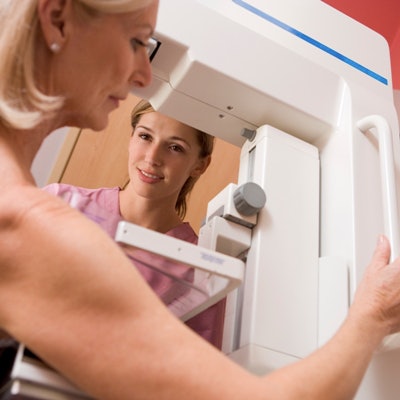
Overdiagnosis of breast cancer -- that is, the detection of cancer on screening that would not necessarily become apparent in a woman's lifetime -- is cited as one of screening mammography's biggest harms. But its prevalence is not as high as some think, according to a study published in the May issue of Radiology.
A clear understanding of overdiagnosis rates is necessary for setting effective screening protocols, particularly for younger women, on whom the concerns about overdiagnosis often center, wrote study author R. Edward Hendrick, PhD, from the University of Colorado in Aurora.
"[Overdiagnosis] rates increase rapidly with age at screening," he wrote. "Screening of women ages 40 to 49 years ... [makes] a negligible contribution of 0.15% to ... overdiagnosis of ductal carcinoma in situ and a contribution of less than 0.1% to the ... overdiagnosis rates of invasive breast cancer and all breast cancers."
2 types of overdiagnosis
There are two ways breast cancer overdiagnosis can occur, Hendrick wrote. Obligate overdiagnosis is when a progressive cancer is found at screening but the woman dies of other causes before the cancer becomes clinically evident. Nonobligate overdiagnosis is when screening identifies a cancer that would never have become clinically evident (Radiology, May 2018, Vol. 287:2, pp. 391-397).
To investigate these two overdiagnosis types, Hendrick used age-specific, all-cause mortality rates from the Human Mortality Database and age-specific breast cancer incidence and mortality rates from Surveillance, Epidemiology, and End Results (SEER) data. He also estimated mean lead times taken from breast cancer screening trials to calculate obligate overdiagnosis rates for ductal carcinoma in situ (DCIS), invasive breast cancer, and all breast cancers for U.S. women undergoing screening mammography.
Hendrick based his research on the assumption that mean lead times for screening mammography (that is, the time between screening detection and clinical detection of breast cancer) are about 24 months for premenopausal women and about 40 months for postmenopausal women.
He found obligate overdiagnosis rates to be strongly associated with a woman's age at screening. Overall obligate overdiagnosis rates among screened women in the U.S. were 9% for DCIS and 7% for both invasive breast cancer and all breast cancers.
| Overdiagnosis rates by age and lead time at screening mammography* | ||
| Age | 24-month lead time | 40-month lead time |
| 40 years | ||
| DCIS | 0.5% | 0.9% |
| Invasive | 0.3% | 0.5% |
| All breast cancers | 0.3% | 0.6% |
| 50 years | ||
| DCIS | 1.2% | 2.2% |
| Invasive | 0.7% | 1.3% |
| All breast cancers | 0.8% | 1.6% |
| 60 years | ||
| DCIS | 2.8% | 5.1% |
| Invasive | 1.8% | 3.4% |
| All breast cancers | 2.1% | 3.8% |
| 70 years | ||
| DCIS | 8.4% | 14.4% |
| Invasive | 6% | 10.3% |
| All breast cancers | 6.5% | 11.1% |
| 80 years | ||
| DCIS | 19.6% | 29.8% |
| Invasive | 13.9% | 21.2% |
| All breast cancers | 14.8% | 22.5% |
A key result from Hendrick's research is that screening women between the ages of 40 and 49 added little to obligate overdiagnosis rates: 0.15% for DCIS and less than 0.1% for invasive breast cancer and all breast cancers. This suggests that obligate overdiagnosis in younger women may not be the harm it's made out to be and highlights the importance of evaluating the necessity of screening in older women, he wrote.
"[Obligate] overdiagnosis due to screening is a greater concern in older women simply because their probability of dying from causes other than breast cancer during the lead time interval is substantial," he wrote. "This finding emphasizes the importance of assessing the health and expected longevity of a woman in advising her decision to screen."




















